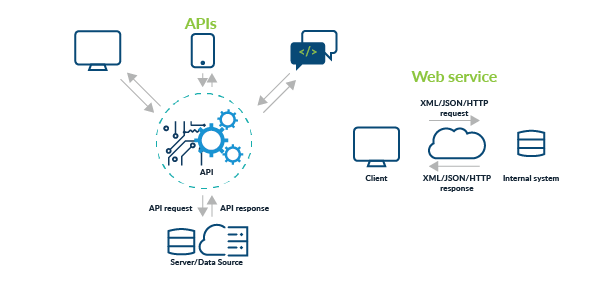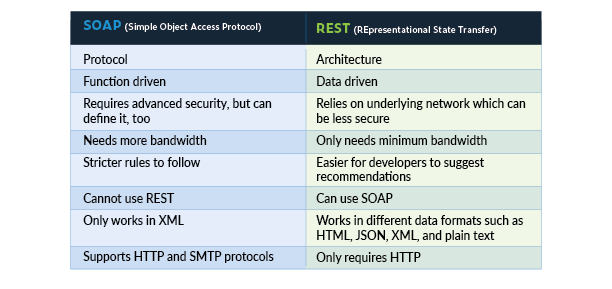Use Agentic AI to generate smarter API tests. In minutes. Learn how >>
Web APIs, Web Services, & Microservices: Basics & Differences
Web APIs, web services, and microservices are terms that are often confused with each other. But there are fundamental differences to note in each term. What are they? Read on to find out.

Web APIs, web services, and microservices are terms that are often confused with each other. But there are fundamental differences to note in each term. What are they? Read on to find out.
The digital world is always changing and, if you want to be successful, you not only need to keep up, but also anticipate what’s coming next. Parasoft is at the forefront of tool and technology development that benefits industries from automotive and medical devices to financial services and hospitality.
One aspect of our expertise covers both web services and web APIs — two things that can work together but do not serve the same purpose. Furthermore, microservices function differently than the former protocols, as well.
In this blog, we’ll review everything you need to know to understand the differences between web APIs vs. web services vs. microservices. Moreover, it discusses how best to use them, too. Like anything, we have to start with the basics and get more granular from there. This blog will cover:
API stands for Application Programming Interface. This interface allows people to further build upon another application’s functionality and data. One might understand them as building blocks you can use to make almost anything as they can be found in everything from Spotify to Yahoo Finance.
The API frameworks allow developers to perform tasks that aren’t all that different from everyday events. For instance, think of giving an order to a server, that server putting your order in, and then bringing back the order when it’s ready. This step-by-step process returns the desired outcome: a tasty meal (in this case). A web-based example might be someone signing up to a new e-Commerce site by using their Facebook account.
Essentially, APIs help sites to communicate on the web and understand information (regardless of programming languages) in order to facilitate processes. HTTP protocol requests allow for sending data and receiving data. The only caveat is that each API requires continuous testing to ensure consistent performance.
As of now, people use four distinct APIs.
Some APIs also require keys for authentication before allowing the mixture of information.
A web service, in contrast to an API, functions more like a resource that’s available using the internet. The network-based resource can be applied to specific tasks, but they require a network to function. This means that all web services are APIs, but only some APIs are web services.
A web service works by supporting interoperable machine-to-machine communication using a network. As such, web services tend to be connected with SOA or Service Oriented Architecture. This allows for different features to be separated then made available as various services within a network.
This testing helps to validate web services in various ways. Functional testing is a main facet along with gauging overall performance, reliability, and security of APIs. Many might consider web services testing similar to unit testing in some ways since it can isolate the function tested to a scope limited to requests and responses associated with a specific protocol.
Industry veterans might recall when Windows Communication Foundation (WCF) replaced Microsoft web service technology from earlier. But the average web service framework can function in many different environments. Some popular options are:

Now that we know what item each is, we now need to understand the difference between Web APIs and Web Services. One of the most obvious differences is that web services, unlike APIs, require a network to function. APIs can function online or offline.
Furthermore, web services are not protocol-agnostic like APIs. APIs can use any design style or protocol, but web services are restricted mostly to SOAP or Simple Object Access Protocol.
Public APIs are often also open source and more transparent about their documentation. Web services sacrifice that transparency for more specific data, partners, and security. However, API security remains a challenge.
REST stands for REpresentational State Transfer and, as an architectural option, it allows for standards among web-based computer systems. These RESTful systems facilitate communication between systems more easily, thus separating server and client concerns.
Other web service APIs include JSON-RPC, XML-RPC, and SOAP.
SOAP makes use of only XML as its data transference format. This means that REST can use SOAP, but SOAP is unable to use REST. But the differences don’t stop there in the REST vs. SOAP list.

Both offer different functionalities for various use cases regarding APIs and web services.
Microservices are architectural styles typically used in modern web apps that require more fragmented functionality. That means that each service is a modular, unique process that can be deployed independently. The lightweight architecture still makes use of SOA and can be especially advantageous for larger companies.
Separate teams can work on various items without encountering difficulties. But this necessitates communication among the different parts which is where APIs come in. However, web services and microservices are not quite the same either.
It’s best to consider a microservice as an autonomous application designed for a single, specific service as part of a larger application architecture. In contrast, a web service acts as a strategy to facilitate service availability across applications by using a web interface.
Microservices, APIs, and web services can all be used separately or in tandem to help your business. The choice between them is likely to depend on the specific protocols, messaging formats, or communication styles you need to support.
Whether you want to implement new services or protocols, or simply audit and verify current ones, Parasoft has the tools to make sure they all behave properly in your applications.